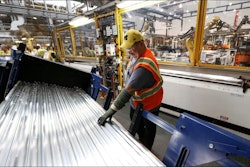The manufacturing industry — where small changes to operating efficiency can have drastic impacts to the bottom line — has never been one to shy away from innovations that can keep their repeatable processes moving faster and more seamlessly. Smarter mobile devices in the hands of workers certainly serve that end.
These are three ways mobility strategies have already begun making big differences in how manufacturing businesses are adjusting their operations and figure to play an increasing role over the next five years.
Mobile Is Putting Efficiency Within Every Manufacturers’ Reach
Until recently, only the largest manufacturers had the resources to invest in costly (but ultimately rewarding) industrial engineering efficiency studies. Designed to analyze manufacturing processes and gather data down to the most basic level of how workers execute specific tasks, these studies look at the exact time spent and motions involved in them doing so — and can lead to significant workflow improvements.
Smart mobile devices (and the apps built on them), though, are not only now inviting small and medium-sized manufacturing businesses to perform such studies affordably, but are also often providing working solutions for the issues those studies reveal.
Within a warehouse, for example, mobile devices can collect real-time data on the locations and movements of workers and equipment. Analysis of that data might find that workers are walking from equipment to a stationary terminal 30 feet away to input data dozens of times each day. While that might sound like a routine and relatively unimportant activity, analysis of the data may find that equipping each worker with a mobile device for completing that data input will save the business a surprising sum.
These are the kinds of realizations often found and acted upon with this sort of efficiency analysis, and mobile — and the data gleaned from it — is really changing what’s available to manufacturers. That’s perhaps particularly true for those without the budget to invest in comprehensive studies.
Mobile Makes Industry Interfaces As Easy To Use As The Best Apps
The comparative elegance of mobile device interfaces has all but eradicated the olden days of thick technical manuals and intensive trainings being a requisite to perform even mundane tasks. In the industrial realm of manufacturing — where every efficiency gain can potentially reap a valuable monetary incentive — the mobile app interfaces that workers are now using are being honed to deliver the most intuitive and error-proof experiences possible.
This is largely now being accomplished through streamlining a worker’s input options and ensuring every worker is inputting uniform and compatible phrasing, resulting in cleaner data collection, better understanding of those inputs and the elimination of input errors. The trend in UI design is a move toward selection of choices from a menu rather than forcing users to input text. With these new interfaces, workers no longer have to answer what can amount to short essay questions but instead can click through a workflow like it’s a quick multiple choice test. Data analysis of these workflows and user feedback guide the way in dealing with corner cases and iterating interfaces for ever more efficiency.
With Internet Of Things Mobility Solutions, Equipment Can Call For Help
They say the squeaky wheel gets the grease. Well, with the Internet of Things (IoT) making a bigger leap from consumer to business applications, each wheel and virtually every other component within manufacturing equipment can now include smart sensors, making it as if each had a tiny mobile phone with which to call in and say how it’s doing in real-time. With equipment and parts sending this feedback to a mobile app — where a technician can then easily manage and oversee this information — any needed repairs or component replacements can be done as part of scheduled maintenance before costly failures and unscheduled downtime occur.
What’s perhaps even more significant, over time the data collected from these sensors will produce data profiles of equipment issues that can be used to achieve predictive intelligence. In this way, software analyzing data from all equipment sensors will be able to proactively inform the technician using the maintenance app on the predicted lifespan of each component, or send a warning if the set of incoming data suggests on oncoming issue based on what is known to have occurred in the past. Equipment failure has always been a huge blow to operational efficiency in manufacturing. But now, with new IoT-based mobility strategies, those failures can be better minimized.
While the efficiency gains of manufacturing’s newer, smarter mobility options are certainly there, the transitioning of workflow processes to mobile app-based interfaces is one that most manufacturers won’t take lightly. Of course, manufacturing decision-makers would love to have a crystal ball helping them to select the strategies that will maintain their relevance deep into the future, and they might be hesitant to make commitments, especially in mobility, given the array of different mobile devices and operating systems out there (iOS, Android, Windows Mobile, etc). However, utilizing mobile app development platforms that allow for simultaneous development across these operating systems can provide another layer of efficiency and cost-effectiveness for these manufacturers, future-proofing their technology decision making by preparing them for whatever changes are to come in mobility technology.
About The Author: Mark Kirstein is the Senior Director of Enterprise Software for Zebra Technologies, where he works closely with Zebra’s RhoMobile Suite.






















